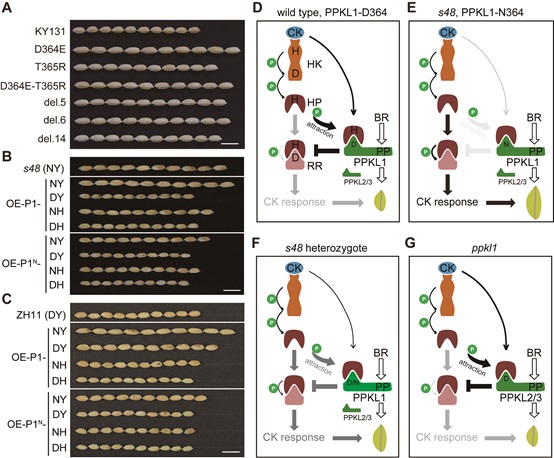Cytokinins are classical, historic plant hormones regulating diverse aspects of plant growth and development, including the important agronomic traits such as grain number in rice. The canonical signal transduction process of cytokinins is well-known as phosphorelay process, which means the transfer of the phosphoryl group among different proteins including histidine receptor kinases (HKs), histidine phosphotransfer proteins (HPs) and responsive regulators (RRs). However, how this process is controlled by plant cells and whether the hormones regulate grain size in rice remain largely unclear.
Recently, researchers from the Institute of Genetics and Developmental Biology of the Chinese Academy of Sciences (IGDB-CAS) reported a new cytokinin signaling component, named PPKL1, which functions via seducing the phosphoryl group to interfere with the hormonal signaling thus suppress grain size in rice. The discoveries were online published in Molecular Plant, an internationally leading plant science journal (https://doi.org/10.1016/j.molp.2021.09.010).
The study showed that a specific amino acid D364 of PPKL1 (Protein Phosphatase with Kelch-Like domains) is most important for the protein function. A specific amino acid D364 resides in a region resembling the receiver domain of RRs, and like RRs, PPKL1 can interact with OsAHP2, one of authentic HPs. Accordingly, PPKL1 can utilize D364 to suppress OsAHP2-to-RRs phosphorelay, whereas mutation of D364 abolishes the effect therefore activates cytokinin response and enlarges grain size.
Interestingly, PPKL1 was previously known as a signaling component of steroid hormone brassinosteroid. This study revealed that it is actually a cryptic inhibitor of cytokinin phosphorelay, and this function is independent of the phosphatase domain that should be required for brassinosteroid signaling. Importantly, editing of the D364-residential region produces a diversity of semi-dominant mutations associated with variously increased grain sizes. Screening of them enables the identification of two genotypes conferring significantly improved grain yield.
According to the introduction by the team's chief scientist Professor TONG Hongning, to meet the food demand due to an increasing population, intense efforts are being made to understand how cellular growth is regulated in cereal grains, the staple food source. This study uncovers not only a noncanonical cytokinin signaling suppressor but also a robust tool for seed rational design, thus makes a significant advance in both basic and applied researches.
Molecular design of rice grain size via manipulation of the cytokinin signaling controller PPKL1 (Image by IGDB)
Contact:
Dr. CHU Chengcai
Institute of Genetics and Developmental Biology, Chinese Academy of Sciences
 Molecular design of rice grain size via manipulation of the cytokinin signaling controller PPKL1 (Image by IGDB)Contact:Dr. CHU ChengcaiInstitute of Genetics and Developmental Biology, Chinese Academy of SciencesEmail: ccchu@genetics.ac.cn
Molecular design of rice grain size via manipulation of the cytokinin signaling controller PPKL1 (Image by IGDB)Contact:Dr. CHU ChengcaiInstitute of Genetics and Developmental Biology, Chinese Academy of SciencesEmail: ccchu@genetics.ac.cn CAS
CAS
 中文
中文




.png)
